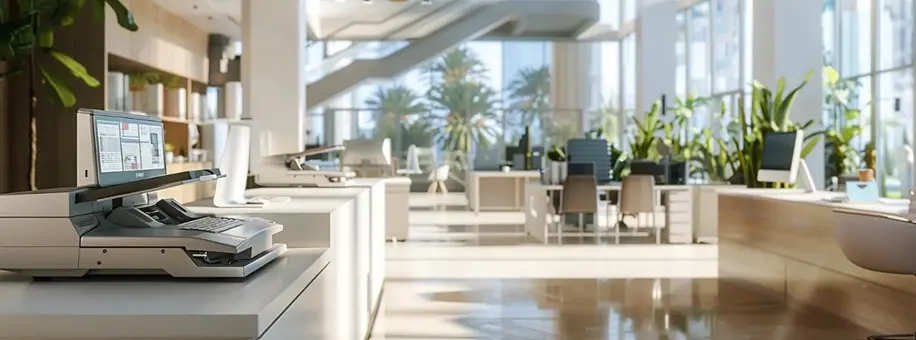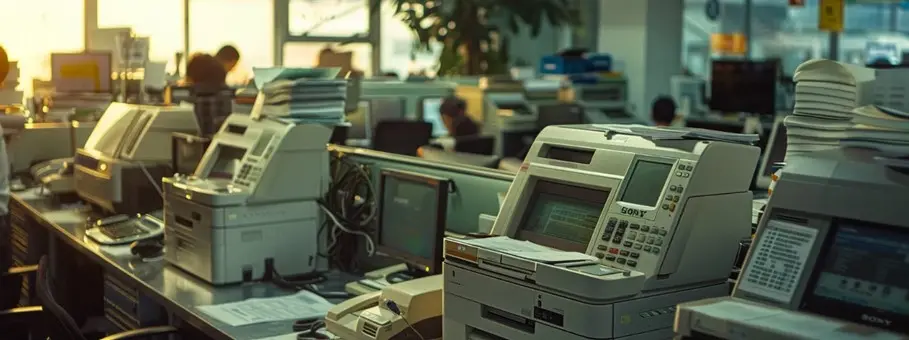For decades, the fax machine was a cornerstone in offices around the world, an emblem of modern business communication. However, with the advent of digital technology, traditional faxing has undergone a sea of change. In today’s fast-paced environment, faxing has transformed from manual, paper-laden processes to slick, digital operations. This evolution bears witness to the adaptability and enduring relevance of fax technology in the digital age. Below, we delve into the history of faxing, explore the transition to software solutions, and envision what the future holds for this communication staple.
The Origins of Fax Technology and Its Rise in Business Communication
Alt text: A spacious office filled with numerous computers and employees, showcasing the use of fax software for efficient communication.
Fax technology dates back to Alexander Bain’s 1843 invention of the electric printing telegraph, laying the foundation for modern business communication. By the mid-20th century, fax machines became indispensable, enabling businesses to transmit documents quickly and securely, revolutionizing workflows for contracts and urgent correspondence.
The 1980s and 1990s marked the peak of fax machine use, symbolizing professional connectivity. While digital tools eventually challenged their dominance, the principle of instant document transmission remains vital. Today, fax software continues this legacy, offering modern, efficient solutions for businesses that need secure and immediate communication.
Transition from Analog to Digital: The Birth of Fax Software
The late 20th century saw a shift towards digital innovations, including fax software, which facilitated the transition from physical machines to computer-based solutions. This allowed users to send and receive faxes electronically, eliminating the need for paper, toner, or a physical telephone line.
Fax software also provided enhanced security features, including encryption and secure transmission protocols, ensuring confidential documents remained safe from unauthorized access. This move not only enhanced convenience but also enhanced the security and integrity of business communication. Digital storage and archiving simplified document management, offering an eco-friendly alternative to paper-heavy workflows.
How Internet Revolutionized Faxing: Cloud-Based and Mobile Fax Solutions
The rise of the internet led to the development of cloud-based and mobile fax solutions, enabling faxing to be accessible to anyone with an internet connection. Cloud-based services provided a secure platform for sending, receiving, and storing faxes online. Mobile faxing expanded this accessibility, allowing users to send faxes from smartphones and tablets, enabling businesses to operate beyond the office.
Cloud-based fax solutions also introduced a collaborative aspect, allowing teams to share fax numbers, access archives, and manage documents in real-time. These solutions also allowed for easy scalability, ensuring compliance with regulations and maintaining robust security standards.
Advantages of Digital Fax Solutions Over Traditional Machines

Alt text: A contemporary office featuring a sleek desk and a computer, showcasing a professional and organized workspace.
Digital faxing offers numerous benefits to modern businesses, including reduced physical space, cost savings, and environmental considerations. It reduces the need for paperless fax machines, reducing the impact on natural resources and carbon footprint. Digital fax services also offer superior operational reliability and uptimes, eliminating paper jams and machine breakdowns.
They also provide enhanced tracking and reporting capabilities, providing valuable insights into communication patterns and document workflows. Compliance is another critical aspect, as digital faxing often comes with built-in features to ensure adherence to laws like HIPAA, GDPR, and SOX, which are essential for legal, healthcare, and financial organizations.
The Future of Fax: Integrating with APIs and Emerging Digital Platforms
Fax technology is evolving with the integration of fax functionality into digital platforms and systems, such as Application Programming Interfaces (APIs). This integration enhances user experience and operational efficiency, allowing businesses to tailor faxing capabilities to their specific needs. The boundaries between different communication modes are blurring as fax becomes a feature within comprehensive digital solutions.
Emerging technologies like artificial intelligence and machine learning are expected to influence the future of faxing, automating sorting, routing, and enhancing security measures. Future developments in fax technology will focus on compatibility with digital trends, user-friendly interfaces, and robust communication standards.
Overall, the transition from physical fax machines to advanced digital solutions demonstrates the enduring versatility and necessity of fax technology in business communication. As the digital landscape evolves, so too does faxing, maintaining its place as a dependable and secure method of document transmission in an increasingly connected world.
Also Read-SkyCrown Casino Official Site Review
